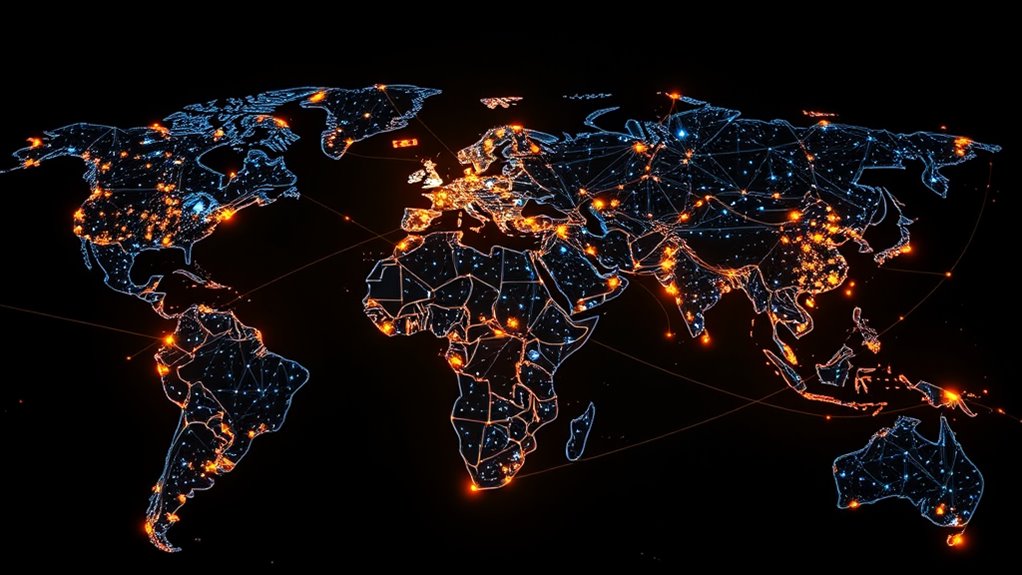The global nanomaterials trade network is a complex and interconnected system that moves tiny particles across borders through a highly coordinated supply chain. It involves specialized facilities, diverse suppliers, and flexible logistics to handle disruptions and guarantee timely delivery. Managing varying international regulations and safety standards adds to the complexity. Staying informed and adaptable is essential for smooth operations. If you want to explore how this intricate network functions and manages risks, there’s more to discover below.
Key Takeaways
- The global nanomaterials trade network is a complex, interconnected system facilitating international movement of tiny particles across specialized facilities.
- It relies on diversified supply chains, flexible logistics, and contingency planning to ensure resilience against disruptions and delays.
- Industry demand spans electronics, healthcare, and energy, requiring an unbroken, agile network to support innovation and market growth.
- Regulatory challenges include varying international standards, safety classifications, and compliance requirements that impact trade flow.
- Managing risks involves staying informed on regulations, collaborating with authorities, and investing in safer, compliant nanomaterial development.

Have you ever wondered how nanomaterials are traded across the globe? The process isn’t just about moving tiny particles from one place to another; it involves a complex, interconnected network that demands meticulous coordination. Supply chain resilience becomes crucial here, as disruptions can ripple through the entire system, delaying shipments and increasing costs. With nanomaterials often produced in specialized facilities located in specific regions, ensuring that supply chains can withstand geopolitical shifts, natural disasters, or logistical hiccups is essential. You need to understand that a resilient supply chain incorporates multiple suppliers, flexible logistics, and contingency plans to prevent shortages or delays. This resilience also involves managing the quality and safety of nanomaterials, which are highly sensitive to contamination and environmental factors. As the demand for nanomaterials grows across industries like electronics, healthcare, and energy, maintaining an unbroken, agile supply chain becomes even more essential.
However, navigating regulatory challenges adds an additional layer of complexity. Different countries impose varying standards and regulations concerning nanomaterials, making international trade a tightrope walk. You might find yourself dealing with inconsistent safety protocols, labeling requirements, or restrictions on certain nanomaterials due to health or environmental concerns. These regulatory hurdles can slow down the movement of goods, increase compliance costs, and create uncertainties that traders must carefully manage. For example, some regions may classify certain nanomaterials as hazardous, requiring special handling and documentation, while others may lack clear guidelines altogether. This patchwork of regulations means you need to stay constantly informed and adaptable, ensuring your supply chain remains compliant across jurisdictions. Staying informed about regulatory frameworks and emerging standards is critical to maintaining smooth international trade operations.
Additionally, regulatory challenges can influence the development of new nanomaterials and their commercial viability. When rules change or become stricter, it might limit the types of nanomaterials you can trade or require costly testing and certification processes. This can impact your market access and profit margins. To navigate these issues, industry players often collaborate with regulatory agencies, participate in standard-setting initiatives, and invest in research to develop safer, compliant nanomaterials. Despite these challenges, the global nanomaterials trade network continues to evolve, driven by innovation and the increasing demand for advanced materials. Your role in this ecosystem requires balancing the need for a resilient supply chain with the complexities of regulation, ensuring that nanomaterials reach markets safely and efficiently. By doing so, you help sustain the growth of this cutting-edge industry while addressing the vital concerns of safety, quality, and compliance.
Frequently Asked Questions
How Do Tariffs Impact Nanomaterials Trade?
Tariff policies directly influence nanomaterials trade by increasing costs and creating trade barriers, making it more expensive for you to import or export these materials. Higher tariffs can slow down market access, reduce competitiveness, and limit innovation. You might face delays or higher prices, which can discourage partnerships and investments. Ultimately, tariffs can hinder the growth of the nanomaterials sector by adding financial and logistical challenges to your trade activities.
What Are the Key Emerging Markets for Nanomaterials?
You should focus on emerging markets like China, India, and Southeast Asia, where nanomaterials innovation is rapidly growing. These regions invest heavily in nanotech research and development, creating new opportunities for trade and collaboration. As these markets develop, you’ll find increased demand for advanced nanomaterials across industries like electronics, healthcare, and energy. Staying ahead means engaging with these emerging markets and supporting their nanomaterials innovation efforts.
How Is Intellectual Property Protected Globally?
Think of intellectual property protection as a fortress guarding your innovations. You actively secure your nanomaterials through patent enforcement, making it difficult for others to copy your ideas. Licensing agreements serve as bridges, allowing you to share technology safely while maintaining control. Globally, these tools help you defend your rights across borders, ensuring your breakthroughs aren’t stolen and that you benefit from your hard work worldwide.
What Are the Environmental Regulations Affecting Trade?
You need to adhere to environmental compliance and sustainability standards that vary across countries, impacting your trade practices. Regulations often include limits on emissions, waste management, and safe handling of nanomaterials. Staying updated on local environmental laws helps you avoid penalties and supports responsible trade. Implementing eco-friendly processes not only guarantees compliance but also enhances your reputation, demonstrating your commitment to sustainable development in the global market.
How Does Supply Chain Resilience Affect Nanomaterials?
Supply chain resilience directly impacts nanomaterials by ensuring consistent quality and availability. When you diversify your supply sources, you reduce risks of disruptions, making your supply chain more robust. Embracing technological innovation helps you track and manage nanomaterials efficiently, improving response times and adaptability. This way, you stay ahead of potential shortages or delays, maintaining steady production and market competitiveness. Resilient supply chains are vital for sustainable nanomaterials trade.
Conclusion
As you consider the vast reach of the global nanomaterials trade network, it’s clear how interconnected and crucial this industry has become. With innovation accelerating, do you realize the immense potential and responsibility we hold to shape a sustainable future? Embracing these advanced materials can open solutions to pressing challenges, but only if we stay informed and proactive. Will you be part of the change that defines tomorrow’s world?









